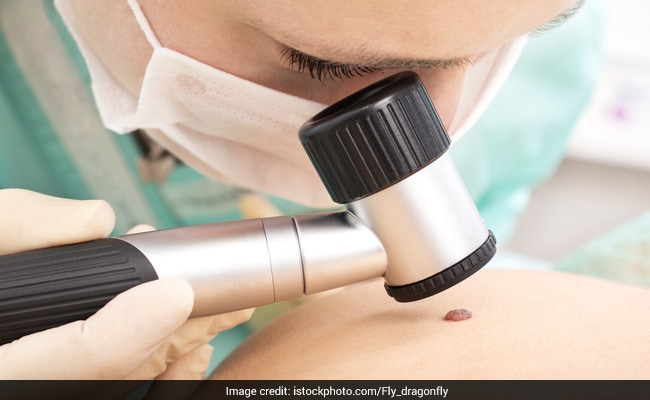How to Do You Know if Moles on Your Head Are Cancerous
How To Differentiate Between A Cancerous And Beneficial Mole
Though information technology is quite rare, moles tin turn into melanoma, which is known to be a serious kind of skin cancer.

It is quite rare that moles get malignant
HIGHLIGHTS
- Information technology is said that people continue to develop moles upwards until the age of 40
- It is quite rare that moles become cancerous
- Backlog exposure to sun's rays tin can increase risks of melanoma
Moles are growth on the peel which develops when pigment cells grow in clusters. Moles unremarkably abound in areas higher up the waist which are exposed to the dominicus. Breast, scalp and buttocks are areas where moles rarely develop. Some moles are on the body since birth, just others announced afterwards in life. Information technology is said that people continue to develop moles up until the age of 40. Moles are as well known as nevus or nevi (plural). While some of these moles fade away with age, at that place are others which stay on the body forever.

Excessive exposure to sun'southward rays can make moles malignant
Photo Credit: iStock
A common mole is going to be effectually five mm wide, which is about ane/4th the size of an inch. Information technology is as pocket-sized as a pencil eraser.
Can a mole get cancerous?
Though it is quite rare, moles tin plow into melanoma, which is known to be a serious kind of pare cancer. While mutual mole is non malignant, people with more than l common moles are more than prone to risks of melanoma. There are a few symptoms which tell if your mole is becoming malignant or not. These symptoms include colour changes in the mole, mole getting unevenly smaller or bigger, mole changing shape, texture or tiptop, skin of the surface of the mole becoming dry or scaly, mole becomes hard or lumpy, if it starts to itch or if it bleeds or oozes are all sign of cancerous mole.
Also read: 7 Reasons For White Spots On Your Pare
Dysplastic nevus
A dysplastic nevus is a kind of mole which may be bigger than a common mole and have a unlike colour, surface and border. This kind of mole is ordinarily smooth and slightly scaly. Information technology has a pebbly surface and an irregular edge which fades in the surrounding skin.
This kind of mole can occur anywhere in the body, but ordinarily happen in areas exposed to the lord's day. But it can also appear in areas which are not exposed to the dominicus, such every bit scalp, breasts and areas below waist.
Almost dysplastic nevus practise not turn malignant. They remain stable over time. However, research says that people with more than than 5 dysplastic nevi are at loftier risks of developing melanoma.
People with dysplastic nevus should avoid getting suntan or sunburn. Dermatologists recommend that people with dysplastic nevi should get their skin checked regularly. Symptoms of a dysplastic nevi turning cancerous are same as a common mole turning cancerous.
People usually practice not get their moles because they don't plow cancerous. Another reason for not removing common moles or dysplastic nevi is that their removal does not foreclose melanoma development.
Likewise read: These Mistakes Are Making Your Peel Age Faster
What is Melanoma
Melanoma is a dangerous pare cancer considering it can spread to other parts of the torso such as liver, lungs, bones and brains. Like well-nigh cancers, information technology is considered benign if the melanoma is detected and removed timely. Melanoma tin develop from a common mole or dysplastic nevus. It tin can even develop on normal skin, the cancer can also develop in the digestive tract, eyes and diverse other parts of the trunk.
In men, melanoma develops on neck, head and back, while in women, it develops on the back or lower legs. People with light skin are more likely to develop melanoma every bit compared to people with night skin.
Also read: six Foods To Swallow For Glowing Skin
Factors that increase chances of melanoma
People with dysplastic nevus or people with more than than 50 common moles are at loftier risks of developing melanoma.
1. Sunlight
Ultraviolet rays of the sun can be harmful for the pare. They can crusade melanoma and various other kinds of skin cancer. People who have severe baking or sunburns are at higher risk of developing cancerous moles. People who get tanned without sunburn are at higher gamble of developing melanoma.

UV rays of the sun tin can increment risks of melanoma
Photo Credit: iStock
two. Skin that burns hands
People who take skin that burns quite hands are more prone to risks of melanoma as compared to others. This includes people who have a pale peel who have many freckles, have cherry-red or blonde pilus and blue or grey eyes.
3. Some medicines
Some antibiotics, anti-depressants and hormones can make your pare more sensitive and increase chances of y'all developing melanoma. These medicines make the skin more sensitive to the sun and suppress the body's immune system.

Some medicines tin can increment take chances of melanoma
Photo Credit: iStock
4. Family unit history
People who accept melanoma in family history are more prone to risks of melanoma. If you have ii or more than family members with melanoma, y'all are at higher risk of developing it.
Disclaimer: This content including communication provides generic information but. It is in no way a substitute for qualified medical opinion. Ever consult a specialist or your own doctor for more than information. NDTV does not merits responsibility for this information.
DoctorNDTV is the one cease site for all your wellness needs providing the most credible health information, health news and tips with adept advice on healthy living, diet plans, informative videos etc. Yous can get the most relevant and accurate info you need about wellness issues like diabetes, cancer, pregnancy, HIV and AIDS, weight loss and many other lifestyle diseases. We accept a console of over 350 experts who assistance usa develop content by giving their valuable inputs and bringing to us the latest in the earth of healthcare.
Source: https://doctor.ndtv.com/skin/how-to-differentiate-between-a-cancerous-and-benign-mole-1841590
0 Response to "How to Do You Know if Moles on Your Head Are Cancerous"
Post a Comment